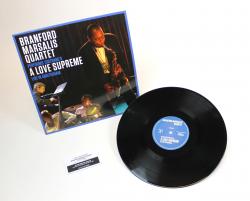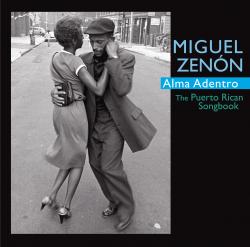 Coltrane’s A Love Supreme: Live in Amsterdam reissue from the Branford Marsalis Quartet out now and available on vinyl for the very first time Read more »
Coltrane’s A Love Supreme: Live in Amsterdam reissue from the Branford Marsalis Quartet out now and available on vinyl for the very first time Read more »
Alma Adentro, Miguel Zenón's new vision for Puerto Rican standards
Publication: State of the Arts, Minnesota Public Ra dio
dio
Author: David Cazares
Date: September 29, 2011
For the cover photo of his latest CD, the alto saxophonist Miguel Zenón picked a stirring three-decades-old image shot by New York Times writer David Gonzalez.
In the middle of a South Bronx street, a sharply dressed couple dances to a band, sharing a tender moment in Mott Haven, then a predominantly Puerto Rican neighborhood that many had written off.
It’s not the image Zenón had in mind for Alma Adentro: The Puerto Rican Songbook, an ambitious recording of popular songs. But he set his original preference for an island scene aside after seeing the black and white photo — which has everything to do with the music he celebrates and honors.
The South Bronx photo is a frozen moment in the Puerto Rican story: graceful and fluid, the dancers’ steps speak to an intensity of spirit amid frustration and struggle. Though the concrete and asphalt surroundings reflect humble circumstances, their expressions are of perseverance and pride. Survivors of hard times, they are alive, celebrating a vibrant culture that connects city streets and island soul.
That same pulse courses through Zenón’s interpretations of songs by some of Puerto Rico’s most important composers from the 1920s to the 1970s: Rafael Hernandez, Pedro Flores, Sylvia Rexach, Bobby Capo and Tite Curet Alonso. The album on Marsalis Music marks the saxophonist’s third exploration of the island’s songs, after Jibaro, an album of music from the Puerto Rican countryside released in 2004, and Esta Plena, a 2009 exploration of the percussive storytelling genre.
For his latest work, Zenón is again backed by stellar musicians from his quartet — pianist Luis Perdomo, bassist Hans Glawischnig and drummer Henry Cole. Added to their exquisite playing are the rich tones of a 10-piece woodwind ensemble put together by composer Guillermo Klein, who expands the music with layers of classical turns. The stunning recording has brought continued acclaim to the highly regarded Zenón, who performed the work at the Newport Jazz Festival.
From the first notes of the Bobby Capo composition Juguete, in which the opening measures are followed by a flurry of notes, it’s clear that Zenón aims to evoke the Caribbean spirit of the original melodies while also using well-structured arrangements to launch soaring — and pensive — explorations into jazz.
Capo’s Incomprendido, played as a salsa tune by the incomparable Ismael Rivera, becomes a soothing ballad. Soft updrafts of English and French horns buffet Zenón’s elegant phrasing on alto saxophone.
On the Rafael Hernandez composition Silencio, the saxophonist starts off with a repeated phrase before turning to an initial melody, itself only an introduction to a roaming and improvisational discussion by Zenón and Perdomo that eventually returns to the repeated hook.
A brilliant performer and MacArthur Foundation award winner who is clearly inspired by the island, Zenón goes beyond a mere tribute to the five composers. Avoiding nostalgia, he transforms the tunes, using just enough of them to retain their essence while taking them in new directions, varying tempo, rhythm and mood.
Employing musical stories that develop themes, create conflict and offer resolution, Zenón creates an infusing mix of Puerto Rican melody and straight-ahead jazz, sharp notes and beautiful phrasing. He mixes long and short phrases, much as a writer would.
That is particularly true on the Syvia Rexach tune Olas y Arenas (Waves and Sand), a mini-suite that showcases the saxophonist’s creative and performing dexterity.
The recording’s blend of formality and spontaneity, of classicism and earthiness also is apparent on the Hernandez tune Perfume de Gardenias, which employs a cadenza to set the stage for Zenón’s crisp and clear improvisational run.
In remaking Puerto Rican standards, Zenón has made an enchanting album of melody and rhythm, a contemporary vision of Puerto Rico in New York.
Like the dancers on the South Bronx street, his luxurious tunes are dressed to the nines, graceful and enduring.
Categories
Tags in Tags
Branford Marsalis Branford Marsalis Quartet ellis marsalis four mfs playin' tunes Joey Calderazzo Justin Faulkner Marsalis Family marsalis music metamorphosen miguel zenon music redeems new orleansFilter by Artist
Marsalis Music Radio
Join Our Mailing List
- RT @bmarsalis: Compliments of the @T_Blanchard archives. https://t.co/4RsXbyEloa — 3 years 10 weeks ago MarsalisMusic